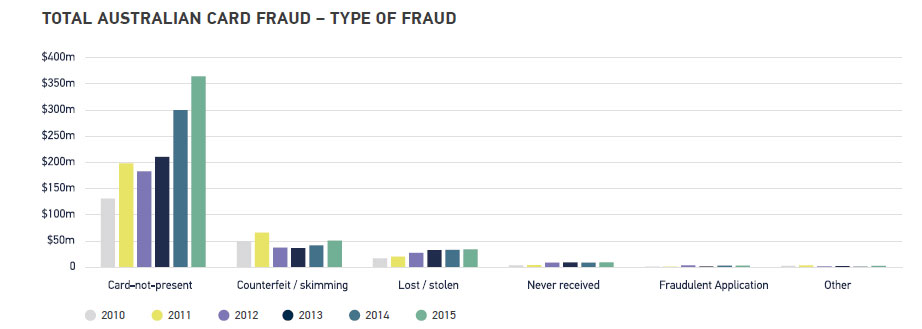The Australian Payments Clearing Association (APCA) have released their 2016 Payments Fraud Report. The rate of fraud across all Australian cheques and cards increased from 20.8 cents in 2014 to 24.5 cents in 2015.
In 2015, Australians spent $1.92 trillion using their cards and cheques; of this overall total, 0.025%, or $469 million, worth of transactions were fraudulent. While some areas of card fraud have declined, overall card fraud has risen due to a significant increase in CNP fraud. Card-not-present (CNP) fraud occurs when valid card details are stolen and then used to make purchases or other payments without the card, mainly online or by phone.
Australian payment cards fraud
Australians are spending more than ever on their cards and the rate of fraud is increasing. The total amount spent on cards in 2015 increased 5% to $689,470 million. The rate of card fraud increased to 66.8 cents per $1,000, up from 58.8 cents in 2014. This compares to the UK’s 2015 card fraud rate of 83 pence per £1000. CNP fraud increased to $363 million, with 62% or $226.3 million occurring overseas. Most of this fraud is likely due to sophisticated malware and phishing attacks and large-scale data breaches. It reflects the growth in cyber-crime generally.
Domestically, CNP fraud increased 38% to $136.7 million. This channel is increasingly attractive to criminals as Australians spend more online and as measures to tighten up card present channels, both in Australia and overseas, take positive effect.
As the US transitions to chip technology – the last significant economy to upgrade from magnetic stripe – criminals are increasing their focus to online domains. Similar to the cards of other jurisdictions such as the UK, this is impacting Australian cards, which are often captured by data breaches occurring in the US.3 Counterfeit / skimming fraud on Australian cards domestically dropped 10% to $22.9 million.
However, knowing the window of opportunity is closing, fraudsters are rushing to use fake cards at US merchants where the magnetic stripe is still accepted. This largely explains the 77% increase in counterfeit / skimming fraud on Australian cards overseas.
Fraud on Australian cards domestically
With chip technology providing strong protection against counterfeit cards in Australia, fraud is increasingly migrating online. Counterfeit / skimming fraud dropped 10% in 2015 to $22.9 million, down from $25.4 million in 2014. Card-not-present (CNP) fraud increased 38% to $136.7 million, up from $99 million in 2014.
Fraud on Australian cards overseas
Fraud on Australian cards is occurring in the US and other countries at terminals that haven’t yet been upgraded to chip technology. Counterfeit / skimming fraud increased 77% to $28.1 million, up from $15.8 million in 2014. Australian cards have been caught up in large scale data-breaches overseas. CNP fraud increased 13% to $226.3 million, up from $200.9 million in 2014.
Overseas payment cards used in Australia
Chip technology is protecting overseas cards used for card present transactions in Australia. Counterfeit / skimming fraud dropped 14% to $8 million, down from $9.3 million in 2014. However CNP fraud on overseas cards in Australia is increasing. CNP fraud increased 7% to $47.8 million, up from $44.7 million in 2014
Cheques used in Australia
Cheque use has dropped more than 70% in Australia over the past 10 years. The total rate of cheque fraud increased to 0.7 cents per $1,000 in 2015, up from 0.5 cents in 2014 – remaining under 1 cent per $1,000.
The rate of fraud increased to 66.8 cents per $1000 spent, up from 58.8 cents in 2014.
APCA is the self- regulatory body for Australia’s payments industry and has 100 members including Australia’s leading financial institutions, major retailers, payments system operators and other payments service providers.

